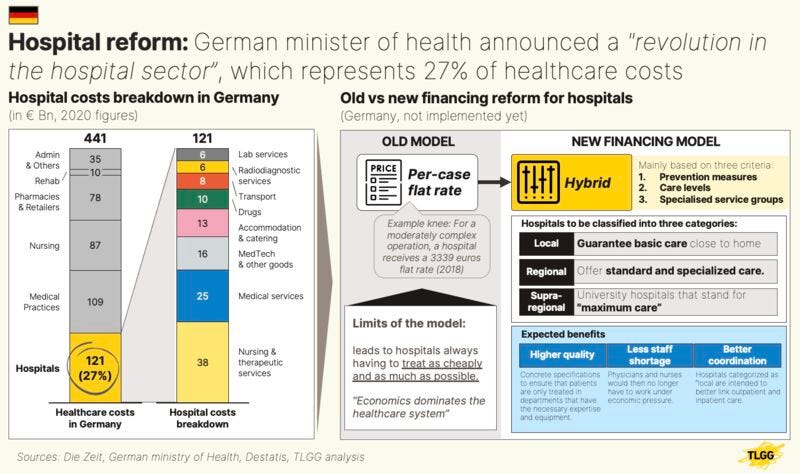health transformation . institute
for continuous health transformation & digital health
Joaquim Cardoso MSc
Founder and Chief Researcher & Editor
December 21, 2022
This is a republication of the post ““Hospitals have serious problems” said German Health Minister Karl Lauterbach recently”, by Thomas Hagemeijer, with the title above.

“Hospitals have serious problems” said German Health Minister Karl Lauterbach recently —
This is why he has announced a new financing #reform of hospitals in #Germany.
Linkedin
Thomas Hagemeijer
December 21, 2022
Good or bad? We wrote down a few thoughts.
- 1️⃣ 𝐒𝐨𝐥𝐯𝐢𝐧𝐠 𝐭𝐡𝐞 𝐫𝐢𝐠𝐡𝐭 𝐩𝐫𝐨𝐛𝐥𝐞𝐦
- 2️⃣ 𝐔𝐧𝐜𝐥𝐞𝐚𝐫 𝐡𝐨𝐰 𝐭𝐡𝐞 𝐫𝐞𝐟𝐨𝐫𝐦 𝐰𝐢𝐥𝐥 𝐩𝐥𝐚𝐲 𝐨𝐮𝐭
- 3️⃣ 𝐍𝐮𝐦𝐛𝐞𝐫 𝐨𝐟 “𝐫𝐞𝐚𝐥 𝐡𝐨𝐬𝐩𝐢𝐭𝐚𝐥𝐬” 𝐢𝐬 𝐞𝐱𝐩𝐞𝐜𝐭𝐞𝐝 𝐭𝐨 𝐝𝐞𝐜𝐫𝐞𝐚𝐬𝐞
- 4️⃣ 𝐀 𝐡𝐨𝐬𝐩𝐢𝐭𝐚𝐥 𝐜𝐞𝐧𝐭𝐫𝐢𝐜 𝐫𝐞𝐟𝐨𝐫𝐦 𝐭𝐡𝐚𝐭 𝐰𝐨𝐧’𝐭 𝐭𝐫𝐚𝐧𝐬𝐟𝐨𝐫𝐦 𝐡𝐞𝐚𝐥𝐭𝐡𝐜𝐚𝐫𝐞
- 5️⃣ 𝐃𝐢𝐠𝐢𝐭𝐚𝐥 & 𝐓𝐞𝐜𝐡 𝐢𝐬 𝐧𝐨𝐭 𝐢𝐧 𝐟𝐨𝐜𝐮𝐬

1️⃣ 𝐒𝐨𝐥𝐯𝐢𝐧𝐠 𝐭𝐡𝐞 𝐫𝐢𝐠𝐡𝐭 𝐩𝐫𝐨𝐛𝐥𝐞𝐦
Everyone acknowledges that the “per-case flat rate” is not working.
The objective was to contain costs, but hospital costs in Germany increased every year by 4,6% in Germany, which is higher than the overall #healthcare costs increase (4,4%) and much higher than the cost increase for “medical practices” (3,2%). (Source: Destatis)
Funnily, Karl Lauterbach was the one driving the “per-case flat rates” reform back in 2003. Now he is killing it.
The objective was to contain costs, but hospital costs in Germany increased every year by 4,6% in Germany, …funnily, Karl Lauterbach was the one driving the “per-case flat rates” reform back in 2003. Now he is killing it.
2️⃣ 𝐔𝐧𝐜𝐥𝐞𝐚𝐫 𝐡𝐨𝐰 𝐭𝐡𝐞 𝐫𝐞𝐟𝐨𝐫𝐦 𝐰𝐢𝐥𝐥 𝐩𝐥𝐚𝐲 𝐨𝐮𝐭
We know the “philosophy” of the new model and that it should “in theory” address many challenges (staff shortage, quality of care, …), but the concrete financing logic is not completely clear yet.
We know the “philosophy” of the new model and that it should “in theory” address many challenges (staff shortage, quality of care, …), but the concrete financing logic is not completely clear yet.

3️⃣ 𝐍𝐮𝐦𝐛𝐞𝐫 𝐨𝐟 “𝐫𝐞𝐚𝐥 𝐡𝐨𝐬𝐩𝐢𝐭𝐚𝐥𝐬” 𝐢𝐬 𝐞𝐱𝐩𝐞𝐜𝐭𝐞𝐝 𝐭𝐨 𝐝𝐞𝐜𝐫𝐞𝐚𝐬𝐞
Reinhard Busse, university professor at the Technical University of Berlin, is behind the new reform.
One of his key theses is that “there are too many #hospitals in Germany”. He argues that Germany just needs 300 hospitals (versus almost 2000 today).
One of his key theses is that “there are too many #hospitals in Germany”. He argues that Germany just needs 300 hospitals (versus almost 2000 today).
The classification of hospitals in 3 levels (local, regional, supraregional) with different financing schemes for each category means that the smaller hospitals (local) will transform into “ambulatory care centers”, coordinating outpatient and stationary care locally.
The classification of hospitals in 3 levels (local, regional, supraregional) with different financing schemes for each category means that the smaller hospitals (local) will transform into “ambulatory care centers”, coordinating outpatient and stationary care locally.
Therefore, these local hospitals won’t be “real hospitals” anymore.
4️⃣ 𝐀 𝐡𝐨𝐬𝐩𝐢𝐭𝐚𝐥 𝐜𝐞𝐧𝐭𝐫𝐢𝐜 𝐫𝐞𝐟𝐨𝐫𝐦 𝐭𝐡𝐚𝐭 𝐰𝐨𝐧’𝐭 𝐭𝐫𝐚𝐧𝐬𝐟𝐨𝐫𝐦 𝐡𝐞𝐚𝐥𝐭𝐡𝐜𝐚𝐫𝐞
“Healthcare has left the building”: a key trend in healthcare is the “unbundling of the hospital”.
Policy makers should therefore prepare for the transition towards a “hospital free” system.
“Healthcare has left the building”: a key trend in healthcare is the “unbundling of the hospital”.
Policy makers should therefore prepare for the transition towards a “hospital free” system.
This reform does not think about healthcare holistically, but is simply trying to save the hospital model, which is a “broken business model” by design, as former Harvard professor Clay Christensen would argue.
This reform does not think about healthcare holistically, but is simply trying to save the hospital model, which is a “broken business model” by design, as former Harvard professor Clay Christensen would argue.

5️⃣ 𝐃𝐢𝐠𝐢𝐭𝐚𝐥 & 𝐓𝐞𝐜𝐡 𝐢𝐬 𝐧𝐨𝐭 𝐢𝐧 𝐟𝐨𝐜𝐮𝐬
Digital Technologies have the potential to transform healthcare.
For example, an estimated 13% to 27% of Emergency Department visits in the United States could be avoided (Source: AHRQ).
Digital triage solutions could address this and thus release pressure (and reduce costs) for hospitals.
For example, an estimated 13% to 27% of Emergency Department visits in the United States could be avoided …
Digital triage solutions could address this and thus release pressure (and reduce costs) for hospitals.
Another example is the implementation of value-based-care within the hospital walls: digital surgery solutions are bringing the right stakeholders and data into one platform, enabling to move towards outcome-based-contracting (a “true” patient centric model).
digital surgery solutions are bringing the right stakeholders and data into one platform, enabling to move towards outcome-based-contracting (a “true” patient centric model).
None of this is really considered in this new reform, which is somewhat “stuck in the middle”:
between the outdated fee-for-service model and a digitally-enabled value-based-care model.
None of this is really considered in this new reform, which is somewhat “stuck in the middle”: between the outdated fee-for-service model and a digitally-enabled value-based-care model.
Originally published at https://www.linkedin.com
Names mentioned
German Health Minister Karl Lauterbach
Reinhard Busse, university professor at the Technical University of Berlin, is behind the new reform.
Former Harvard professor Clay Christensen












